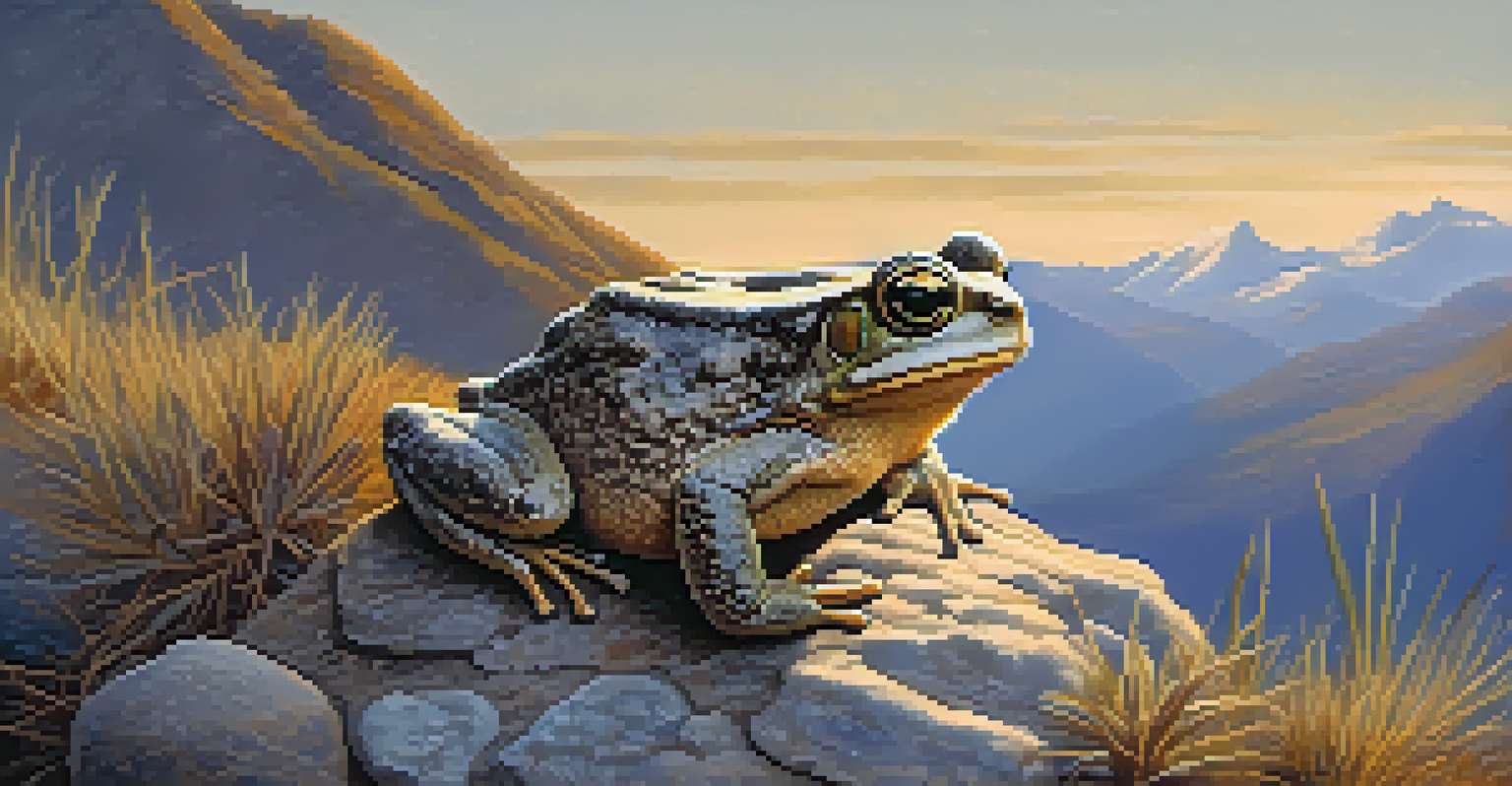Unique Amphibians of Peru: Discovering the Hidden Gems

Introduction to Peru's Rich Amphibian Diversity
Peru is a treasure trove for nature lovers, particularly when it comes to amphibians. With its diverse ecosystems ranging from the Amazon rainforest to the Andes mountains, the country boasts an astounding variety of species. Amphibians play a crucial role in maintaining ecological balance, acting as both predator and prey in their habitats.
What we are doing to the forests of the world is but a mirror reflection of what we are doing to ourselves and to one another.
Exploring Peru's amphibian population is like embarking on a treasure hunt; each species is a unique gem waiting to be discovered. From vibrant colors to unusual behaviors, these creatures offer insight into the health of their ecosystems. By understanding and appreciating these unique amphibians, we can better protect the rich biodiversity of Peru.
In this article, we will dive into some of the most unique amphibians found in Peru, highlighting their characteristics, habitats, and the importance of conservation efforts. Let’s uncover the hidden gems of Peru’s amphibian world!
The Enigmatic Glass Frog: A Transparent Wonder
One of the most fascinating amphibians in Peru is the glass frog, known for its translucent skin that allows you to see its internal organs. Found primarily in the cloud forests, these frogs are not just a sight to behold; they also play a vital role in their ecosystem. They are sensitive indicators of environmental health, making their presence essential for biodiversity.

Glass frogs use their transparent skin as a defense mechanism, blending seamlessly into their surroundings to avoid predators. Their unique mating calls, which can be heard during the wet season, add a symphonic touch to the rainforest ambiance. It's not just about their looks; their behavior and ecological role make them a key species to study.
Peru's Amphibians: A Biodiversity Gem
Peru's diverse ecosystems host a remarkable variety of amphibian species that play vital roles in maintaining ecological balance.
Unfortunately, habitat loss and climate change threaten these delicate creatures. Conservation efforts are crucial to ensure their survival, emphasizing the need for sustainable practices in the regions they inhabit.
The Colorful Poison Dart Frog: Nature's Vibrant Palette
Another striking example of Peru's amphibian diversity is the poison dart frog. Known for their bright colors, these frogs serve as a warning to predators about their toxicity. Found in various habitats from rainforests to wetlands, their vivid hues are not just for show; they reflect their ecological niche and evolutionary adaptations.
In every walk with nature one receives far more than he seeks.
These tiny frogs are fascinating not only for their appearance but also for their cultural significance. Indigenous people have historically used their toxic secretions to poison darts for hunting, highlighting their connection to local traditions. This unique relationship between humans and poison dart frogs showcases the intricate balance of nature and culture.
Despite their resilience, poison dart frogs face threats from habitat destruction and pollution. Continued research and conservation efforts are essential to ensure that these vibrant amphibians thrive in their natural environment.
The Mysterious Andean Toad: Adapted to High Altitudes
The Andean toad is a remarkable species that has adapted to the high-altitude environments of Peru. Found in the Andes mountains, these toads are known for their robust bodies and unique adaptations to survive in harsh conditions. Their ability to thrive at elevations over 3,000 meters sets them apart from many other amphibians.
These toads play a significant role in their ecosystems, influencing insect populations and serving as indicators of environmental changes. Their breeding habits, which involve laying eggs in streams, are crucial for the next generation's survival. This connection to their habitat highlights the interdependence of species within the ecosystem.
Unique Adaptations of Amphibians
Amphibians like the glass frog and Titicaca water frog showcase fascinating adaptations that highlight their survival strategies in challenging environments.
However, climate change poses a significant threat to the Andean toad's survival. As their high-altitude habitats become less stable, it's vital to monitor their populations and implement conservation strategies to protect these unique amphibians.
The Rare Titicaca Water Frog: A Lake's Guardian
The Titicaca water frog, endemic to Lake Titicaca, is one of the largest frog species in the world. Known for its distinctive appearance and unique adaptations, this frog has a flattened body that allows it to navigate the lake's depths with ease. Its role as a keystone species in this fragile ecosystem cannot be overstated.
These frogs have developed specialized breathing techniques, allowing them to absorb oxygen directly from the water. This adaptation is crucial in their high-altitude habitat, where oxygen levels can be low. The Titicaca water frog's unique biology showcases the wonders of evolutionary adaptation in response to environmental challenges.
Sadly, the Titicaca water frog is under threat due to pollution and invasive species in its habitat. Conservationists are working tirelessly to protect this unique amphibian and restore the health of Lake Titicaca for future generations.
The Unusual Darwin's Frog: A Parent’s Sacrifice
Darwin's frog is another unique amphibian that showcases a peculiar parenting strategy. Found in the forests of southern Peru, the male Darwin's frog incubates the eggs in his vocal sac until they hatch. This unusual method of carrying offspring is both fascinating and a rare example of parental care in amphibians.
The frogs’ ability to camouflage themselves among the leaves and branches offers them protection from predators. Their muted colors and small size make them nearly invisible in their natural habitat, emphasizing the importance of adaptation for survival. Observing these frogs in the wild is like witnessing nature's creativity at work.
Community Involvement in Conservation
Local communities are essential in conservation efforts, using their traditional knowledge to promote sustainable practices that protect Peru's unique amphibian populations.
However, habitat destruction and climate change threaten their populations. Raising awareness about the unique traits of Darwin's frog can help promote conservation efforts focused on protecting their natural habitats.
Conservation Challenges Facing Peru's Amphibians
Despite the incredible diversity of amphibians in Peru, many species face significant conservation challenges. Habitat destruction due to deforestation, agriculture, and urbanization compromises the delicate balance of these ecosystems. As amphibians are often the first to show signs of environmental stress, their decline can indicate larger ecological issues.
Pollution from agricultural runoff and climate change further exacerbates the threats to amphibian survival. These factors disrupt breeding patterns and lead to population declines, making conservation efforts urgent and necessary. Protecting these unique creatures requires a multifaceted approach that includes habitat restoration and community engagement.

Organizations and local communities are increasingly coming together to develop conservation initiatives. By raising awareness and promoting sustainable practices, we can help ensure that Peru's unique amphibians continue to thrive for generations to come.
The Role of Local Communities in Conservation Efforts
Local communities play a crucial role in the conservation of Peru's amphibians. Their traditional knowledge and connection to the land provide valuable insights into sustainable practices that benefit both people and wildlife. Engaging communities in conservation efforts fosters a sense of ownership and responsibility towards their natural resources.
Community-led initiatives, such as habitat restoration projects and educational programs, can significantly impact amphibian populations. By involving locals in conservation, we empower them to be stewards of their environment. This collaborative approach not only aids in protecting amphibians but also enhances the community's livelihood through ecotourism and sustainable resource management.
As we explore the unique amphibians of Peru, it's essential to recognize the interconnectedness of humans and nature. Together, we can work towards a future where both thrive harmoniously, celebrating the hidden gems of Peru's natural world.